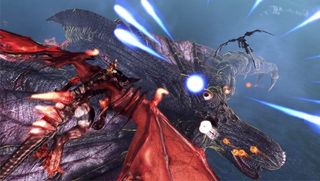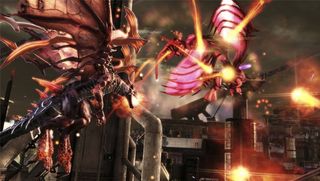The first time you battle an army of laser beam-shooting jellyfish with your fireball-shooting dragon, you'll probably get destroyed. It'll take a few missions to get the hang of dodging enemy projectiles (less a matter of threading the needle, more a matter of mashing the barrel roll button). You'll no doubt fiddle with the sensitivity of your targeting reticle a half-dozen times in an attempt to turn your laughable kill count into something respectable. But once the acclimation process is over, Crimson Dragon shows its true colors as a fun arcade rail shooter with a surprising amount of depth.

As a member of the Icarus Division on planet Draco (Draco, dragons, huehuehue), you're tasked with saving mankind from a contagious, deadly virus called Crimsonscale. Turns out, the local wildlife--including explosive bat things, the aforementioned jellies, and humongous blimp-like dragons that dwarf your mount in size--are carriers of the disease, so really your task is to murder every living creature on Draco that isn't a human. While you could speculate that this is perhaps some kind of commentary on mankind's destructive nature, the simple premise provides reason enough to embark on mission after mission, where you'll proceed to obliterate everything that moves from the back of your winged companion.
Most levels are on-rails, and you'll auto-fly through some beautiful environments, ranging from oceanic vistas to white-hot lava caverns. These segments are all about fast-paced, focused combat, as you concentrate on dodging enemy attacks, collecting items, and blasting stuff away with your dragon's built-in homing rocket launchers. Okay, so maybe Crimson Dragon doesn't adhere to typical fantasy tropes, but it is a great deal of mindless (and surprisingly challenging) fun for the most part, except when levels suffer from rare frame dips and/or excessive visual noise. Nothing's quite as infuriating as missing out on a perfect score because you couldn't see a group of red-colored enemies floating inches above red-colored lava.

You might eventually find yourself wishing you could just take total control of your dragon to go off and explore--at which point Crimson Dragon reads your mind and hands over the reins to full 3D movement. Some stages feature a free flight mode, allowing you to fly wherever you want. Great for exploration? Sure. Great for combat? Oh God, no. While these bits are wonderful opportunities for taking in the sights and scale of each level, they make controlling your dragon more difficult, because it's easy to lose track of your targeting reticle once you also have to worry about the orientation of your fire-breathing bestie.

Originally designed as a Kinect game, Crimson Dragon is now a controller-based game with a few Kinect supplements. You can use voice commands for things like navigating its menus (a much quicker alternative to the comparatively laggy controller navigation) and controlling your Wingman. I found the latter to be a bit impractical, as "advance forward" is kind of a mouthful when you're focusing on an intense fight. In terms of movement controls, you can lean to the left or right to make your dragon perform a barrel roll, but why bother when the controller offers a 100-percent accuracy rate?
After only a few missions, you'll have experienced all of the game's objectives and enemy types: Kill everything in the area! Dodge the jellyfish lasers! Pick up those magical floating triangle things! You'll encounter these scant few goals over and over, and while their familiarity is rarely distracting, a couple more would've gone a long way toward keeping levels feeling fresh through the end of the game.
Still, the segmented nature of each stage will keep you on your toes, as the aforementioned objectives are constantly rotated and scored independently based on your performance. Because end-of-mission rewards--including experience points for leveling up your dragon and money for buying new dragons--are tied to your skill, you'll be incentivized to replay the 15-minute levels multiple times to maximize your profits. This is especially true if you've got friends playing, as a well-implemented leaderboard system pops up after each section of a stage is completed, comparing your score to that of your pals. The itch to top the charts is hard to ignore when you're constantly being teased that xXxBigPimpin420xXx is beating you out. (Why this person is your friend, I will never understand.)
Once you become familiar with Crimson Dragon's basic mechanics, its more intricate systems start opening up. Combat is a rock-paper-scissors game of learning which elemental attacks are effective against which; it's basically a poor man's Pokemon, but with only three types (fire, wind, and light) to worry about. This forces you to put some thought into which dragon to use, as you'll eventually have access to several. Because you can equip each with a secondary attack of any attribute, you'll almost always have an answer to any monster you might face. I just wish I had any need to use a dragon other than my starter, who'd wracked up some 1,136 kills worth of experience and transformed into an unstoppable badass by the time I added a third dragon to my roster.

Even when I knew I'd be going up against enemies of my dragon's opposing attribute, I could just hire a Wingman to offset my weakness. The Wingman system allows you to buy an AI-controlled co-op partner that uses the exact dragon and stats from other riders on the leaderboards. Your chances at nabbing a high score are drastically increased with an AI version of xXxBigPimpin420xXx at your side (actual cooperative multiplayer will supposedly be added sometime in December), especially in missions that emphasize total annihilation. Using them does present a sort of a tradeoff, though. Obtaining Wingmen is quite expensive, and they can only be used for a set number of missions before expiring. But the added damage they bring to a mission make them worth the cost.
There's a surprising amount of game to be had here for $20, even if some of Crimson Dragon feels lacking. Its pretty world and detailed monsters are slightly offset by a lack of variety, and its free flying segments feel kind of pointless when they don't let you do anything you otherwise couldn't on-rails. But its score-based, arcade core and digestible levels will keep you coming back for more until you're sittin' pretty on top of the leaderboards. After all, no self-respecting human would stand idly by while xXxBigPimpin420xXx holds the number one spot.

The spiritual successor to Panzer Dragoon offers a compelling on-rails experience, even if it feels a bit lacking in some areas. With multiple dragons to own and level up, as well as and addictive scoring system complete with leaderboards, there are a few good reasons to plop down $20.


